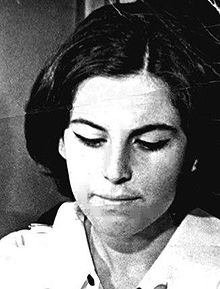Diana Arón
Diana Arón | |
|---|---|
 | |
| Born | Diana Frida Arón Svigilisky 15 February 1950 |
| Disappeared | 18 November 1974 Villa Grimaldi, Santiago, Chile |
| Died | 10 January 1975 Villa Grimaldi, Santiago, Chile |
| Occupations |
|
| Partner | Luis Muñoz González |
Diana Frida Arón Svigilisky (15 February 1950 – 10 January 1975) was a Chilean journalist[1] and a member of the Revolutionary Left Movement (Movimiento de Izquierda Revolucionaria, MIR).[2] She was kidnapped, tortured and forcibly disappeared by agents of the Pinochet dictatorship.
Biography
[edit]She studied at the Hebrew Institute and then journalism at the Catholic University, developed her professional practice on Canal 13, belonging to the same university. After graduating, she worked as a reporter for Onda magazine of Editorial Quimantú.[3] Arón was a member of the Revolutionary Left Movement and part of the editorial team of its newspaper, El Rebelde ("The Rebel").
Disappearance
[edit]After the 1973 military coup and subsequent military dictatorship, Arón was forced to go underground. On November 18, 1974, she was arrested by agents of the then-active secret police of Chile, the Dirección de Inteligencia Nacional (DINA), and taken to Villa Grimaldi, where she was tortured by Miguel Krassnoff, who was seen leaving the torture room with bloody hands, screaming "a Marxist, and on top of that, a Jew!".[4] After that, she was forcibly disappeared and her body was never found.[5] According to her partner, Luis Muñoz González, who had also been captured and tortured, a Captain of the army informed him that Arón had been killed on 10 January 1975, after trying to escape. Multiple investigations were carried out to find her body, none of which were successful.
Two legal processes were initiated in the 1970s, both ultimately ending in acquittal. In 2004, five members of the DINA –Manuel Contreras, Miguel Krassnoff, Osvaldo Romo, Pedro Espinoza and Marcelo Moren– were sentenced in terms ranging from 10 to 15 years to be served out at the Punta Peuco Prison for their involvement in her kidnapping.[6]
See also
[edit]References
[edit]- ^ Schwaner, Luis (17 November 2018). "La sonrisa de Diana Arón". diarioUChile. Retrieved 9 August 2019.
- ^ Memoria Viva caso Diana Arón
- ^ Editora Quimantu
- ^ Guzmán J., Nancy (2000). Romo: Confesiones de un torturador. Grupo Planeta. p. 149. ISBN 9789562472647.
- ^ "Caso Aron: Suprema anula amnistía y confirma condena a cúpula DINA". Archived from the original on 1 July 2019. Retrieved 23 December 2017.
- ^ Accatino, Daniela (23 March 2018). "Diana Frida Arón Svigilsky". Expedientes de la Represión (in Spanish). Retrieved 8 December 2023.
External links
[edit]- Diana Arón en Una Historia Necesaria
- Ernesto Carmona. Morir es la Noticia. Santiago de Chile: Ernesto Carmona Editor. 1998
- 1950 births
- 1970s missing person cases
- 1974 deaths
- Chilean Jews
- Chilean revolutionaries
- Chilean socialists
- Chilean women journalists
- Enforced disappearances in Chile
- Kidnapped Chilean people
- Missing person cases in Chile
- People killed in Operation Condor
- Pontifical Catholic University of Chile alumni
- Chilean writer stubs
- South American journalist stubs
- Mass media in Chile stubs
